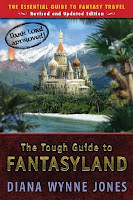One of the best primers on fantasy world building I have seen is Diana Wynne Jones’s Tough Guide to Fantasyland. Wikipedia describes it as a loving sendup of common fantasy tropes, which it is, but it can also beread as a cautionary primer for writers against unexamined fantasy clichés. 
Years ago the book was recommended to me by the leader of Seattle Writer’s Cramp, Steve Gurr, when he pointed out some arbitrary apostrophes I’d inserted into place names or secondary character names in the novel I was submitting for critique at the time. (His point about the apostrophes wasn’t that one ought not use apostrophes in imaginary place names, but that if I am not a linguist, like Tolkien was, I might consider doing that sparingly. (And yes, Jones does have a humorous entry on Apostrophes in the book.)
I read all of Tough Guide to Fantasyland and found numerous inspirations to reconsider elements of my worldbuilding which I had not before examined.
Some of My Favorite Examples
COLOR CODING: is very important in Fantasyland. Always pay close attention to the color of the CLOTHING, hair and eyes of anyone you meet. It will tell you a great deal. Complexion is also important: in many cases it will be color coded too.
1. Clothing. Black garments normally mean EVIL, but in rare cases it may mean sobriety, in which cases a white ruffled collar will be added to the ensemble. Gray and red clothing mean that the person is neutral but ending to EVIL in most cases. Any other color is GOOD, unless too many bright colors are worn at once, in which instance the person will be unreliable. Drab color means the person will take little part in the action, unless the drab is also torn or disreputable, when the person will be a loveable rogue.
2. Hair. Black hair is EVIL, particularly if combined with a corpse-white complexion. Red hair always entails magical POWERS, even if these are only latent. Brown hair has to be viewed in combination with eyes whose color are the real giveaway (see below), but generally implies niceness. Fair hair, especially if it is silver-blonde, always means goodness.
3. Eyes. Black eyes are invariably EVIL; brown eyes mean boldness and humor, but not necessarily goodness; green eyes always entail talent, usually for magic but sometimes for music; hazel eyes are rare and seen generally to imply niceness; gray eyes mean niceness and healing abilities (see HEALERS) and will be reassuring unless they look silver (silver-eyed people are likely to enchant or hypnotize you for their own ends, although they are not always EVIL); white eyes usually blind ones, are for wisdom (never ignore anything a white-eyed person says); blue eyes are always GOOD, the bluer, the more good present; and then there are violet and golden eyes. People with violet eyes are often of Royal, and, if not, always live uncomfortably interesting lives. People with golden eyes just live uncomfortably interesting lives, and are usually rather fey in the bargain. Both these types should be avoided by anyone who wishes for a quiet life. Luckily it seldom occurs to those with undesirable eye colors to disguise them with ILLUSION, and they can generally be detected very readily. Red eyes can never be disguised. They are EVIL and are surprisingly common.
4. Complexion. Corpse-white is evil, and it grades from there. Pink-faced folk are generally midway and pathetic. The best face-color is brown, preferably tanned, but it can be inborn. Other colors such as black, yellow, blue and mauve barely exist.
So, if a character is wearing green, is blue-eyes and brown-faced, you will probably be okay. CAUTION: do not apply these standards to our own world. You are likely to be disappointed.
CLOTHING: Although this varies from place to place, there are two absolute rules:
1. Apart from ROBES, no garment thicker than a SHIRT ever has sleeves.
2. No one ever wears socks.
COATS: do not exist in Fantasyland–CLOAKS being universally preferred–but TURNCOATS do.
CLOAKS: are the universal outer garb of everyone who is not a barbarian. It is hard to see why. They are open in the front and require you at most times to use one hand to hold them shut. … etc.
Amazon Link
Consider reading this aloud to like-minded geek friends.

